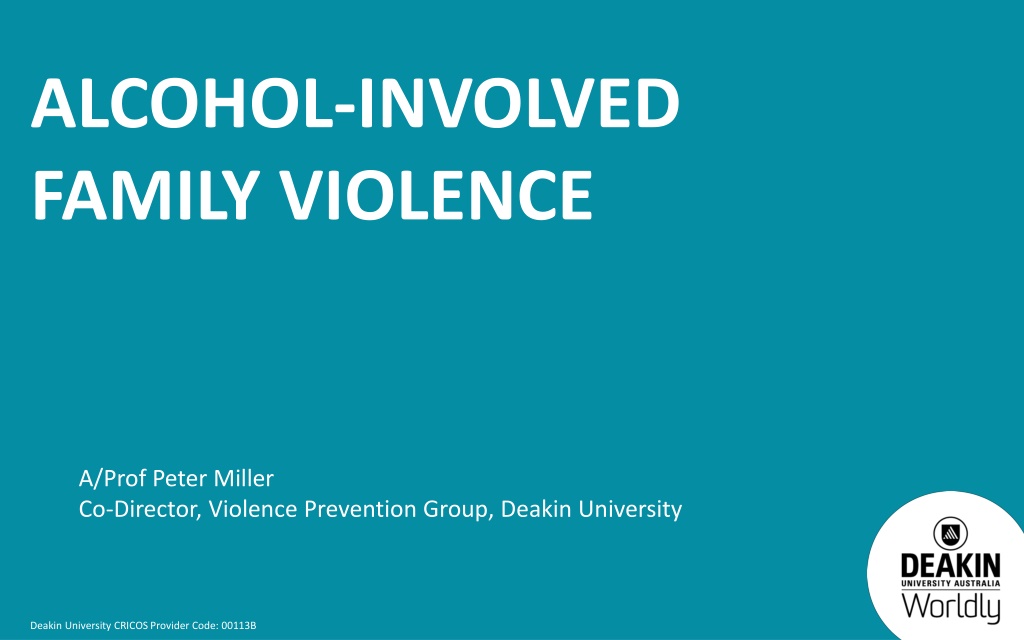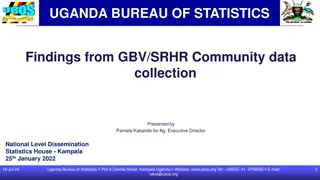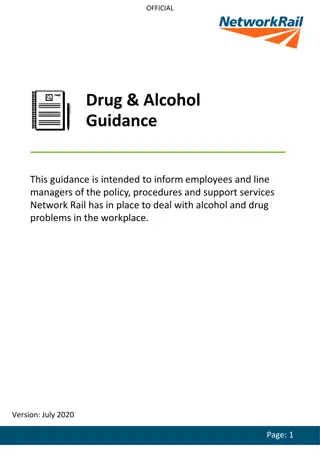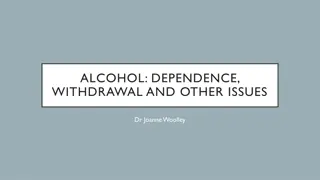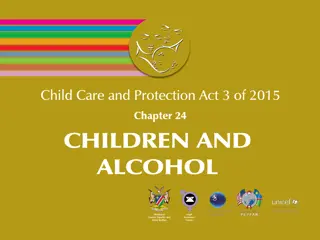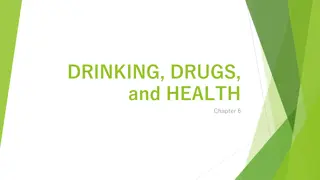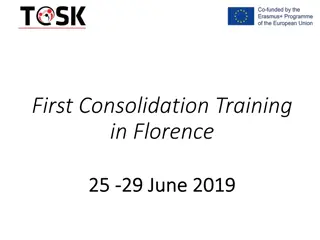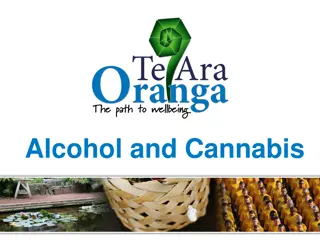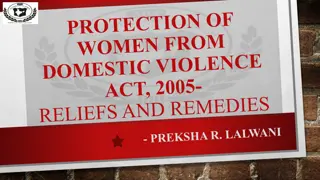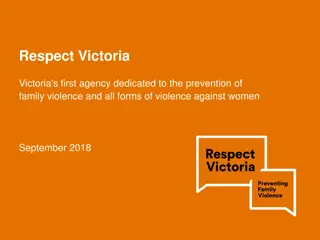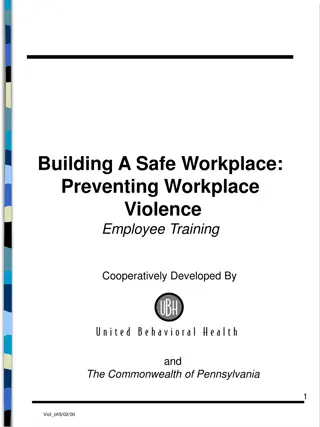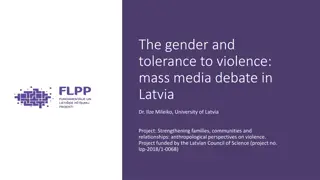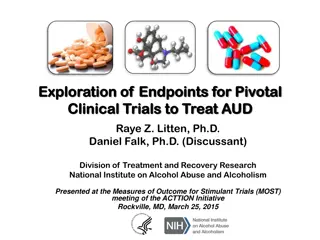Alcohol-Involved Family Violence Studies
Studies conducted by A/Prof. Peter Miller and Deakin University explore the relationship between alcohol use and family violence. Research findings, trends, and associations between alcohol, domestic violence, and police data are highlighted. The evidence suggests a complex interplay between alcohol consumption and the incidence of family and domestic violence.
Download Presentation

Please find below an Image/Link to download the presentation.
The content on the website is provided AS IS for your information and personal use only. It may not be sold, licensed, or shared on other websites without obtaining consent from the author.If you encounter any issues during the download, it is possible that the publisher has removed the file from their server.
You are allowed to download the files provided on this website for personal or commercial use, subject to the condition that they are used lawfully. All files are the property of their respective owners.
The content on the website is provided AS IS for your information and personal use only. It may not be sold, licensed, or shared on other websites without obtaining consent from the author.
E N D
Presentation Transcript
ALCOHOL-INVOLVED FAMILY VIOLENCE A/Prof Peter Miller Co-Director, Violence Prevention Group, Deakin University Deakin University CRICOS Provider Code: 00113B
OUR STUDIES Core studies DANTE: Dealing with Alcohol in the Night Time Economy POINTED: Patron Offending and Intoxication in Night Time Entertainment Districts Alcohol and Drug Involvement in family and Domestic Violence in Australia (ADIVA) All of these studies were funded by NDLERF Deakin University CRICOS Provider Code: 00113B
ALCOHOL AND FAMILY & DOMESTIC VIOLENCE (FDV): THE EVIDENCE THUS FAR Deakin University CRICOS Provider Code: 00113B
OVERVIEW AOD use (particularly alcohol) increases: the incidence of FDV Severity of FDV Association is complex and multifaceted However, AOD use and FDV can involve a reciprocal bi- directional relationship Either problem can increase risk of the other. Deakin University CRICOS Provider Code: 00113B
FDV AND POLICE DATA Trends and typologies 41% of domestic assault incidents in NSW were flagged by police as alcohol related (Grech & Burgess, 2011) International estimates 25-45% Around 50% of offences are once-off offences Deakin University CRICOS Provider Code: 00113B
ALCOHOL USE AND FDV Associations Any drinking day: 8 times higher odds of male-to-female violence 11 times higher odds of SEVERE male-to-female violence. Heavy drinking days: 19 times higher odds of SEVERE male-to-female violence Deakin University CRICOS Provider Code: 00113B
ALCOHOL USE AND FDV Policy relationships Moderate drinkers make up the bulk of offenders and victims Outlet Density - strong WA: residential violence increased by 26 per cent for every 10,000 L of pure alcohol sold VIC: a 10 per cent increase in off-licences was associated with a 3.3% per cent increase FDV. Price not conclusive USA: a 1% price increase was associated with a 3.1 3.5% reduction in wife abuse . Trading hour restrictions (Brazil) reductions in assaults against women Reductions in homicides of women Deakin University CRICOS Provider Code: 00113B
TYPES OF FDV FDV exists on a continuum: (1) coercive controlling violence (F 37%, M 6%) (2) violent resistance (F 6%, M 28%) (3) situational couple violence (F 25%, M 19%) (4) Non-violent (F 33%, M 6%) Johnson, 1995; Kelly & Johnson, 2008 Deakin University CRICOS Provider Code: 00113B
LONGITUDINAL PREDICTORS OF FDV CHILD ABUSE, NEGLECT AND MALTREATMENT Early Adversity Child and adolescent behaviour problems Substance Use in Adolescence THE FIRST THOUSAND DAYS OF LIFE Costa, Kaestle, Walker, Curtis, Day, Toumbourou & Miller, 2014 Deakin University CRICOS Provider Code: 00113B
ADIVA The current study 1. Australia-wide representative safety survey the role of different types of liquor outlets 2. Police data in three jurisdictions * describe the trends in family violence impact of AOD use on breaches of intervention orders. Deakin University CRICOS Provider Code: 00113B
FINDINGS Postal survey, pilot 915 participants, 18 - 92 years Over half of participants (n=506) reported lifetime violence 84 participants (9.1%) experienced violence in past 3 months Deakin University CRICOS Provider Code: 00113B
FINDINGS Postal survey, pilot Alcohol involved in 40% of all cases of violence IPV: Daily drinking, 8.6 Coercive Control Victimization: Female, 1.98 Hazardous drinking, 1.3 Drug dependence, 8.9 Coercive Control Perpetration: Male, 0.98 Hazardous drinking, 2.6 Deakin University CRICOS Provider Code: 00113B
SOLUTIONS Overview WHO framework A response framework for Australia Specific AOD interventions Deakin University CRICOS Provider Code: 00113B
A RESPONSE FRAMEWORK A national strategic approach ALL forms of violence Across the life-course Across levels of prevention A research agenda programs must evaluate and demonstrate impact A focus on evidence-based intervention A specific component devoted to piloting new approaches Deakin University CRICOS Provider Code: 00113B
A RESPONSE FRAMEWORK Ante-natal Childhood Adolescence Adulthood Enforcement Reduce maternal substance use Reduce alcohol/drug supply Education regarding the impacts of substance use Primary Comprehensive education and labelling campaigns Education should be a curriculum item Reduce alcohol advertising Parenting interventions aimed at whole-of-family Pre-natal support for Strengthening Families Therapeutic interventions vulnerable parents Secondary Community nursing Social and Emotional Community nursing Peer Mentoring visits Competence visits Situational interventions Family Drug Court /Mandated Treatment Psychological interventions -restricting trading hours Tertiary Child protection Child protection Social and Emotional Swift and Certain Justice (including abstinence (including abstinence Competence Training Offender rehabilitation conditions) conditions) -SADV Deakin University CRICOS Provider Code: 00113B
SOLUTIONS Specific AOD approaches Combined treatments Drug treatment Substance Abuse-Domestic 1 year generic 12 step Violence (SADV) FDV reduced from 60% to 35% of the Stella Project participants Deakin University CRICOS Provider Code: 00113B
WHAT IF WE COULD REMOVE ALCOHOL FROM THE EQUATION? Deakin University CRICOS Provider Code: 00113B
SOLUTIONS Swift and Certain Justice HOPE Hawaii (meth) Drug tests daily 24/7 (alcohol) Breath tests 7am, 7pm daily Immediate incarceration Randomly assigned Immediate incarceration 2-3 days 8-24hrs 99% tests passed servable on weekend if employed 66% never failed one, 9% failed twice Deakin University CRICOS Provider Code: 00113B
SOLUTIONS Swift and Certain Justice 24/7 South Dakota HOPE Hawaii Drunk diving 78% Assaults decline by 12% Domestic assaults decline by 16%. Statewide reports of FDV declined 10% Deakin University CRICOS Provider Code: 00113B
CONCLUSIONS A holistic approach is the only one which ultimately work It is time for a National Strategy to Prevent Violence AOD-related FDV is low-hanging fruit Swift and Certain Justice for AOD-related crime AOD specific interventions for offenders and customised support for victims with AOD problems Deakin University CRICOS Provider Code: 00113B
THANK YOU the alcohol industry has no role in the formulation of alcohol policies, which must be protected from distortion by commercial or vested interests (BMJ, 2013). Margaret Chan, Director of the WHO Our team: Nic Droste, Ashlee Curtis, Lucy Zinkiewicz, Florentine Martino, Arlene Walker, Elise Cox, Kerri Coomber, Beth Costa, Shannon Hyder, Steven Litherland, Anders Sonderlund, Molly Bickerton, Bianca Tassone, Ashley Rapazzo, Eric Koukounas, Andrew Day, Darren Palmer, John Toumbourou, Deakin University CRICOS Provider Code: 00113B
